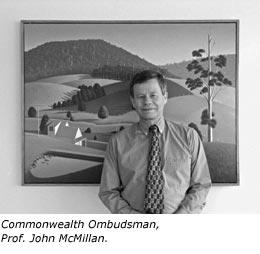Commonwealth Ombudsman Annual Report 2003-04 | Foreword
![]()
Foreword
 The annual reports of the Commonwealth Ombudsman have been important documents in the history and development of the office. Numbering twenty-seven reports, they chart the history of the office, each year giving a
snapshot of complaint investigation in the preceding year, while reflecting on the role and philosophy of the office.
The annual reports of the Commonwealth Ombudsman have been important documents in the history and development of the office. Numbering twenty-seven reports, they chart the history of the office, each year giving a
snapshot of complaint investigation in the preceding year, while reflecting on the role and philosophy of the office.
This year's report seeks to capture some of that experience and wisdom of the office. This is chiefly done in chapters of the report that look at how the Ombudsman's office handles thousands of complaints and inquiries each year about Australian Government administration.
A distinguishing feature of the office is that it deals with problems and complaints against government arising across Australia and across all portfolios of government. This offers a unique perspective on the difficulties that people face in relation to government. At the same time, it poses many challenges for the office.
To be effective, the office must be accessible to all Australians; it must understand law and public administration and how they can apply differently both over time and from one area of government to another; the office must be efficient and effective; it must be balanced and professional in how it relates to government and to the public; and it must contribute something to government, both nationally and in our own region of the world.
The individual chapters of this annual report explain how the office has tried to meet these diverse challenges. One way is to maintain a national operation, spread over eight separate offices (a description of each office was given in last year's annual report). Another is to develop portfolio expertise within the office, through teams that focus on areas such as defence, immigration, law enforcement, social support and taxation. Technology, benchmarking and internal review likewise play a key role in complaint management.
Another strategy of the office is to pinpoint common difficulties that people face in dealing with government. Delay, lost records, incorrect advice, complaint handling and compensation claims are among the recurring themes in Ombudsman investigations that are taken up in this report. Differentiating the systemic problem areas in public administration from temporary malfunctions in program delivery is important in deciding how to address problems and, over time, how to lift the standard of government performance.
These and other issues taken up in this report are designed to show the different facets of the Ombudsman's office. At one level the office discharges the same function each year: receiving individual complaints and inquiries from the public and deciding whether a remedy is required. Yet the office is more than the sum total of the individual cases it handles. It has, in addition to its operational role, a symbolic role as an accountability institution in government. The perpetual oversight role of the office—popularly termed the watchdog function—is another facet. A commitment to improving government administration is also a dimension of the complex relationship the office maintains with government agencies.
Another feature of Ombudsman work reflected in this report is that the role of the office is not static. The way that complaints are received and resolved is different now from how that function was discharged in former years, and it will be different again in the future.
Some of the changes are obvious, such as technological innovation in complaint handling. Other changes are subtler. For example, less importance is given to a theme pervading the Ombudsman Act that each complaint can lead to a separate investigation into whether there was agency defect. Identifying and correcting administrative deficiency is still a strong focus of the office, though it is matched by a similar concern to find an appropriate resolution to the everyday difficulties that people experience in their dealings with government. Finding an outcome can be as important as targeting the incident or misunderstanding that gave rise to a difficulty.
This changing role of the office is taken up in the cover design. The design is reminiscent of movement and growth over time. The patterns in tree rings express varying time periods and conditions that correspond in the organised world to changes in the political, legislative and administrative landscape.
Prof. John McMillan
Commonwealth Ombudsman
